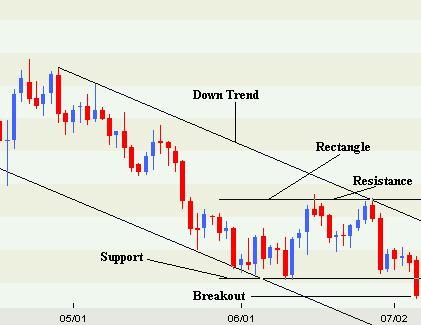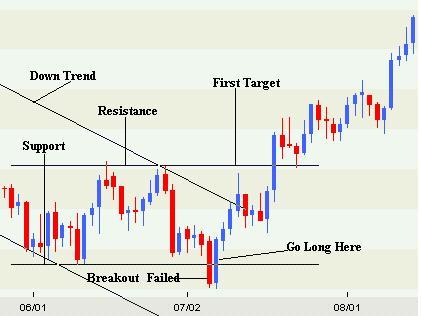Home | Previous | Next Lesson
This Lesson Can Be Printed See Instructions Below
How To Nail The Market When Everyone Else Is Wrong
Picture the scene - you have done your analysis and have been waiting for the breakout of a range. You might even have identified a head and shoulders or double bottom. So anyway, you have a trade all set up and you are just waiting for the move.
Let's say you have identified a rectangle and are waiting for the breakout. You have your orders set up so that if it breaks up you are automatically taken long. You're trading an hourly chart so you are checking it frequently to see if there has been any movement. Suddenly- bang- the market starts motoring up. Your buy stop takes you long and you are sitting pretty. You start to watch the market and check to see that your stop loss is in place. Then suddenly without warning the same bar that made you feel like you should start counting your money turns around and heads back down. |
As it heads back down you just know it's going to take your stop - and it does. Now you no longer have a position. You start to look around for another entry or setup to get a trade on: but wait - we just missed a huge opportunity.
In this lesson I want to explain a great way to benefit when everyone else is wrong. Here's the theory. Most trader are very single minded when they trade. They get an idea into their head and it stays there.
Once they have decided they are going to go long on a breakout they generally stick with it. This is particularly true of well-defined technical levels like the 52-week high or low. It could even be a trend line or chart pattern. The thing is, it could be anything.
If you follow only one or two markets you will know what I am taking about. Even though you shouldn't listen to other traders you will probably have a fair idea of where the major support and resistance levels everyone is watching.
Remember also that trading is as much about the study of human behavior as anything else. Once one of those big levels breaks everybody and their dog will try and get on the right side of the move. This is where we come in - listen up, this is important.
When The Market Doesn't Do What You Expected It To Do, Chances Are It's Probably Doing The Opposite.
For example - lets look at our greedy little friends who went long on the breakout and got wrong footed. Some of their stops will have been taken and some of the kamikaze crowd without stops will be filling their pants. This is exactly where we jump in - when everybody else is exercising damage control.
To take advantage of this we need two plans. Plan A and Plan B. As you probably guessed, Plan A is to go with the crowed: if the market breaks in the direction you first assumed it might, then you are there. You have an entry point, a stop loss level and a probable target already worked out.
Plan B is where we excel. If the market breaks the other
way, we also have a plan.

In the chart above you can see that we had a down trend followed by some consolidation. The market first went down to form support and then headed back up to the upper trend line.
Now very often consolidation will break in the same direction as the trend, so it wouldn't be unreasonable to expect the market to break down, which it did. This would have taken us short, with a stop probably at the previous resistance and a measured target on the down side of the difference between the support and resistance.
This is what happened next.

Instead of continuing down the very next bar became a reversal bar.
Side Note: For the two period reversals up, the first
period should be at the end of a strong down move. The close
should be near the low of that period and it is preferable
that this low is a new recent low. The second period should
open near the close of the first period and should regain
most if not all of the first period's losses and close near
the high of the first period. There does not need to be a
reversal bar for this to work. It just so happens there was
one in this example.
So now the market is doing exactly the opposite of what we
expected. Being the opportunists that all good traders should
be - we close the short position and open a long position
with a stop below the low of the failed breakout.
We are now long the market with a stop loss in place - but we need a target. The first target I would head for would be the previous resistance. The reason I would choose this is simple. We may be headed into a long period of consolidation and the price might start oscillating between support and resistance.
However as the failed breakout also happened to be a two period reversal, I might keep the long and just monitor what happens at the resistance level. Depending on market conditions I might also have an order to add to my long position.
The important thing here good buddies, is to always be ready to exploit what the market is doing. When you see an obvious failure of a - trend line, support/resistance or a chart pattern, have a plan in place to take action. Don't just watch it - exploit it.
I know some traders who only trade this way. They watch for easily identifiable patterns, which everyone is watching and exploit the failed move.
Good Trading
Best Regards
Mark McRae
Information, charts or examples contained in this lesson are for illustration and educational purposes only. It should not be considered as advice or a recommendation to buy or sell any security or financial instrument. We do not and cannot offer investment advice. For further information please read our disclaimer.
![]() To PRINT or save a copy of this lesson in PDF format simply click the PRINT link. This will open the lesson in a PDF format which,
you can then PRINT. If
you are unfamiliar with PDF or don't have a FREE copy of Arobat
Reader see instructions.
To PRINT or save a copy of this lesson in PDF format simply click the PRINT link. This will open the lesson in a PDF format which,
you can then PRINT. If
you are unfamiliar with PDF or don't have a FREE copy of Arobat
Reader see instructions.